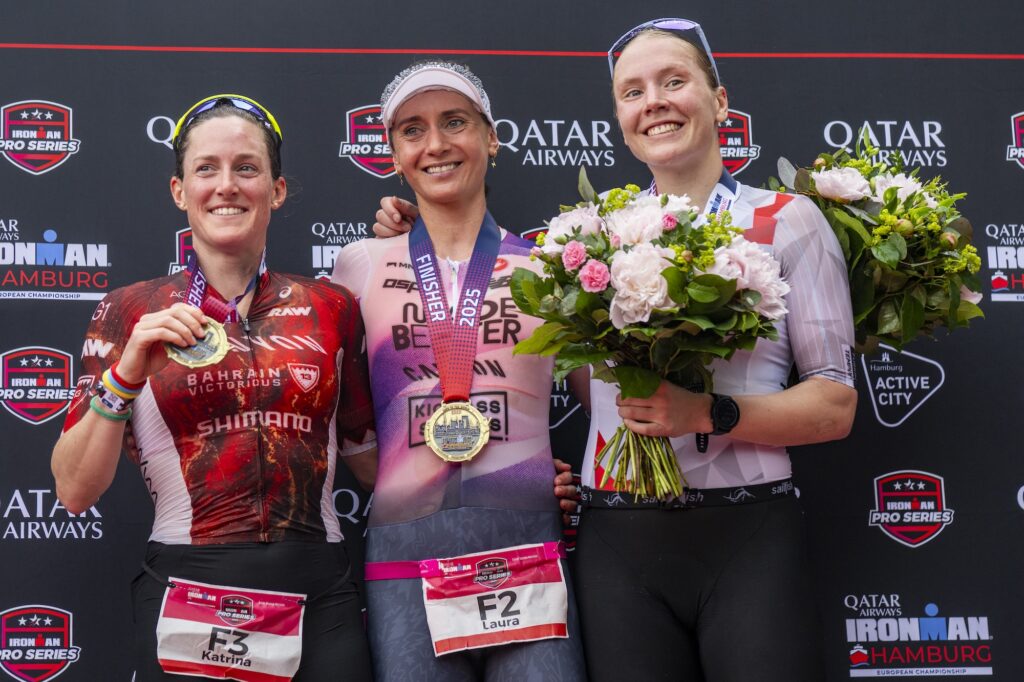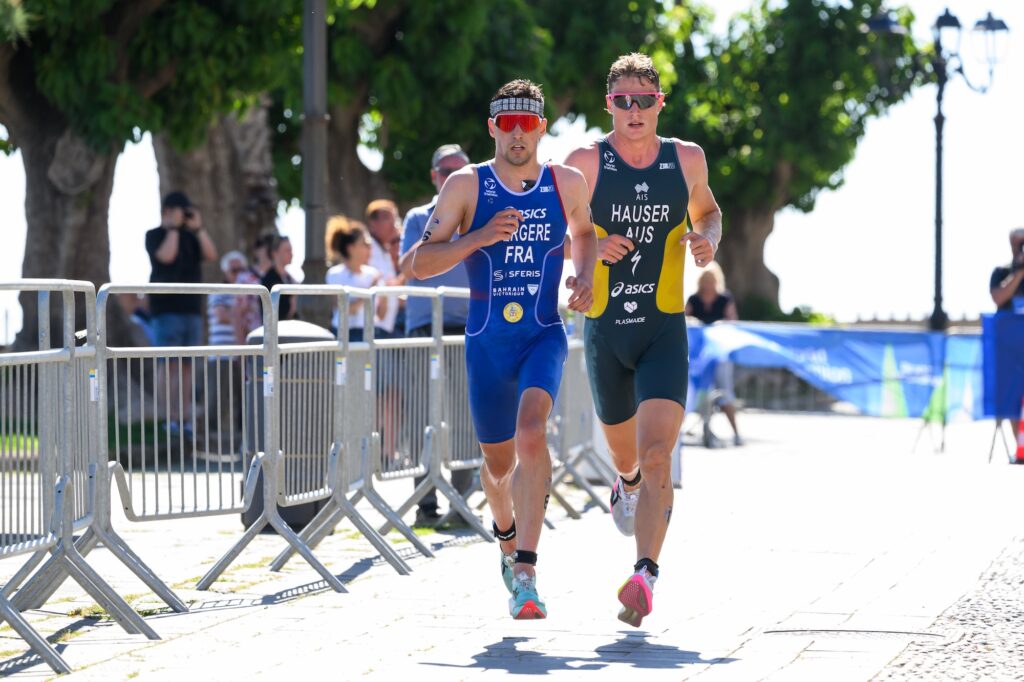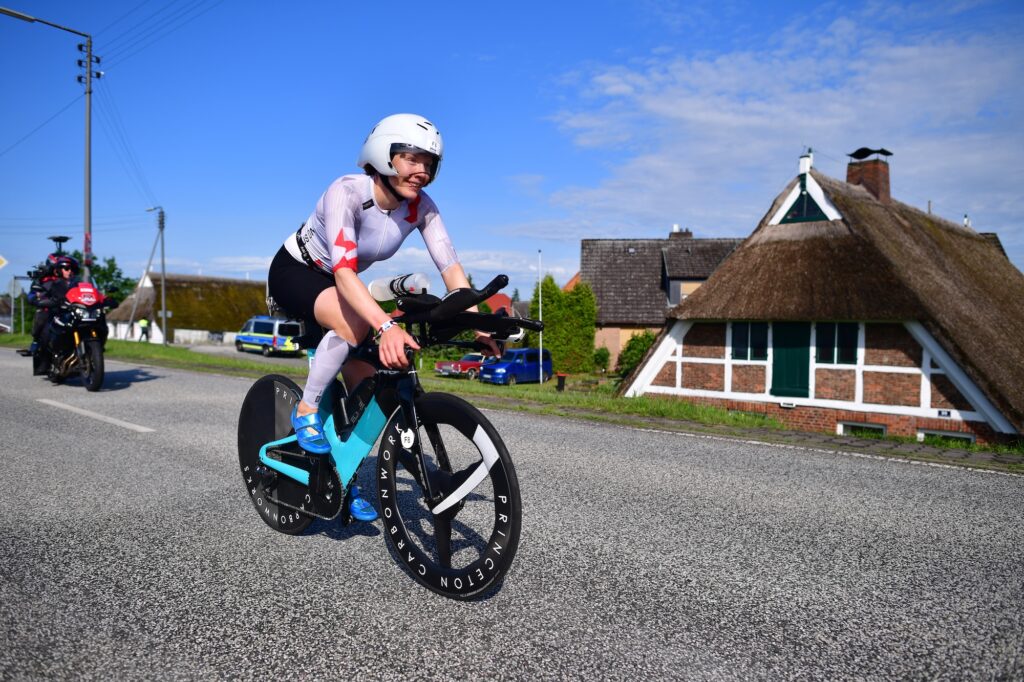We Noticed: 5 Takes From This Weekend’s Racing in Alghero, San Francisco and Hamburg

Katrina Matthews of Great Britain (2rd place), Laura Philipp of Germany (1st place) and Solveig Lovseth of Norway (3rd place) (Photo by Jurij Kodrun/Getty Images for IRONMAN)
Story by Ben Snider-McGrath
This past weekend saw multiple big races in the world of triathlon, with a stop in the World Triathlon Championship Series (WTCS) in Alghero, Italy, T100 San Francisco, and the women’s IRONMAN European Championship in Hamburg, Germany. While those three races gave fans of the sport a lot to think about, there was one other big achievement in Brazil, too. Here are a few things we learned after an exciting weekend of triathlon.
What it Takes to Beat Taylor Knibb — and Why Her Loss Isn’t a Huge Deal
Everyone is making a big deal of Taylor Knibb’s second-place finish behind Julie Derron at T100 San Francisco. Considering the fact that this was Knibb’s first loss on the T100 circuit, it’s fair that her result is big news, but it’s important to provide context and look at it a bit closer. Firstly, Knibb has expressed that performing well at Kona is her goal for 2025, and she toed the line in San Francisco just over a month after her second-place performance at IRONMAN Texas (a result that booked her ticket to the Big Island).
Saturday’s race was also her first middle-distance event since last December, when she won her third consecutive 70.3 world title, so her early-season build has likely been more IRONMAN-focused. Even so, she still finished on the podium, and with a comfortable gap of more than two minutes between herself and third-place finisher Kate Waugh. Yes, she lost, and yes, it is a shock to see anyone take their first loss after so many wins in a row, but if what it takes to beat Taylor Knibb is having her race (her second) IRONMAN weeks before you compete against her, that’s not necessarily good news for the rest of the women’s field at upcoming events.
Variety in the WTCS is Fun

Leo Bergere and Matt Hauser at WTCS Alghero. Photo: Petko Beier | petkobeier.de
In recent years, the WTCS circuit has been dominated by a small group of men and women. Alex Yee, Hayden Wilde, and Leo Bergere have been staples of the WTCS podium, while it’s a safe bet that Cassandre Beaugrand and, to some extent, Beth Potter, will be battling for the win in any race they enter. We’re only three races into the 2025 WTCS calendar, but this season has been a tad different so far — and it’s been fun to see things shaken up a bit.
Wilde raced the first event of the year in Abu Dhabi and took the win, but he announced plans to focus on longer races ahead of this season. (That plan has been put on hold for a bit after a horrific car accident in Japan last month.) Yee has also taken a step back from WTCS racing, as he spent the first chunk of his season preparing for the London Marathon. Bergere has been at two of the three races, finishing fourth in Japan and third in Italy, and Australia’s Matthew Hauser seems to have picked up the slack left behind by Yee and Wilde, but even so, the races have been much more exciting and less predictable, with a different winner at each on so far.
On the women’s side of things, there have also been three different winners in three races, with Germany’s Lisa Tertsch having the only repeat podium performance of 2025 so far (she won in Abu Dhabi and finished third in Yokohama). And, yes, we get that Cassandre Beaugrand might have been a two-time winner were it not for her crash in Yokohama, but she did miss the first race of the season to focus on a fast running event. There is every chance that this variety of winners and podium finishers will stop in the coming months as the WTCS season progresses, but there is no denying that, for now, it has been fun to see a bigger group battle for the top spots at races.
Middle-distance to WTCS Could be the Move
Back just 10 years ago, the path for a professional triathlete was simple. If you had the legs to compete in short-course, draft-legal racing, you did that and tried to do your best in the yearly rankings and at the Olympics. After retiring from shorter events, you moved on to 70.3 racing, and if you fared well there, you hopped up to IRONMAN. It was believed that you would ruin yourself for short-course racing if you jumped to longer events. Nowadays, there doesn’t seem to be one set path for triathletes, and more recently, it looks like middle-distance racing could actually help athletes in their short-course careers.
Take a look at Bergere, who finished third at the 70.3 world championship in December, second at T100 Singapore in April, then dropped down to a pair of Olympic-distance races in Yokohama and Alghero in May, finishing in the top five in both. Wilde has also proven that the jump up in distance followed by a step back down can work seamlessly. And, before the Norwegian connection of Kristian Blummenfelt and Gustav Iden really committed to full-distance racing, they were doing an impressive job of bouncing back and forth between the two as well. Canadian Tyler Mislawchuk won his first 70.3 race in Pucon earlier this year and then had a fifth-place finish in Yokohama, too.
There are plenty more examples on both the men’s and women’s sides of athletes who have done this moving around quite successfully, and it looks like it will continue to be the trend.
Solveig Løvseth is the real deal

Solveig Lovseth. Photo by Alexander Koerner/Getty Images for IRONMAN
The talk of the weekend had to be the battle between Laura Philipp and Kat Matthews in Hamburg at the IRONMAN European Championship, but Solveig Løvseth’s result deserves some praise. The 25-year-old Norwegian was racing in the first IRONMAN of her career, but to anyone who didn’t know this fact, they would have assumed she was a seasoned veteran of the distance. Løvseth was right with Philipp and Matthews as they exited the water, and she only lost 85 seconds to Matthews and 32 seconds to Philipp on the ride – and that was despite a mechanical issue along the way that forced a stop to fix an extension on her bars. She completed the 112-mile bike with the third-fastest split of the day, clocking 4:24:10.
The run is of course where IRONMAN rookies will likely fall off. It’s impressive to swim 2.4 miles and bike 112 miles well, but none of it matters if you can’t follow it up with a solid marathon. Well, Løvseth was up to the test, once again dropping the third-fastest split of the race, this time with a 2:46:40 run. Her final time was an amazing 8:12:28, just two minutes off of the previous IRONMAN world record (Philipp set a new record of 8:03:13) and the fastest IRONMAN debut ever. Løvseth will undoubtedly be a name to look out for, not just for the rest of the 2025 season, but for many years to come.
Manoel Messias Runs Sub-2:30
We figured that Patrick Lange was the man most likely to achieve the sub-2:30 marathon, but it turns out that achievement now goes to Manoel Messias, who took second in his first IRONMAN race in Brazil behind Argentina’s Luciano Taccone. Messias competed at the Olympics last year and appears to be following the post-Olympic move-to-long-distance trend.




I´d say, 10 years ago, less than 10% of the pro athletes on the Ironman circuit came through this path … There are obvious examples, yes - but many really.